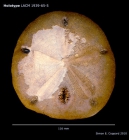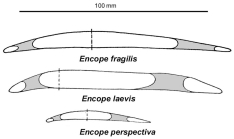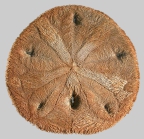WoRMS name details
Encope laevis H.L. Clark, 1948
513257 (urn:lsid:marinespecies.org:taxname:513257)
unaccepted (subjective junior synonym)
Species
marine, brackish, fresh, terrestrial
recent only
Clark, H. L. (1948). A report of the echini of the warmer eastern Pacific, based on the collection of the Velero III. <em>Allan Hancock Pacific Expeditions.</em> 8, ii-xii, 225-352., available online at http://www.biodiversitylibrary.org/page/5512986#page/259/mode/1up
page(s): 327-328; pl. 54: fig. 45, pl. 55: fig. 46 [details]
page(s): 327-328; pl. 54: fig. 45, pl. 55: fig. 46 [details]
Distribution Nicaragua
Status While Coppard & Lessios (2017) did not formally synonymize E. laevis with E. micropora, it is clear from their paper that...
Distribution Nicaragua [details]
Status While Coppard & Lessios (2017) did not formally synonymize E. laevis with E. micropora, it is clear from their paper that...
Status While Coppard & Lessios (2017) did not formally synonymize E. laevis with E. micropora, it is clear from their paper that they consider them to be synonyms. They wrote: "However, with the exception of specimens of E. micropora insularis from Isla Socorro, there was no structure to support these variants [of E. micropora] either in morphology (as indicated by the specific and subspecific names) or in geographical location. Subclades did not include all members of a morphospecies; the same subclade included morphologically divergent specimens, such as those of E. micropora micropora, mixed with E. wetmorei and E. laevis. [details]
Kroh, A.; Mooi, R. (2025). World Echinoidea Database. Encope laevis H.L. Clark, 1948. Accessed through: World Register of Marine Species at: https://www.marinespecies.org/aphia.php?p=taxdetails&id=513257 on 2025-04-12
Date
action
by
![]() The webpage text is licensed under a Creative Commons
Attribution 4.0 License
The webpage text is licensed under a Creative Commons
Attribution 4.0 License
Nomenclature
original description
Clark, H. L. (1948). A report of the echini of the warmer eastern Pacific, based on the collection of the Velero III. <em>Allan Hancock Pacific Expeditions.</em> 8, ii-xii, 225-352., available online at http://www.biodiversitylibrary.org/page/5512986#page/259/mode/1up
page(s): 327-328; pl. 54: fig. 45, pl. 55: fig. 46 [details]
basis of record Kier, P. M. & Lawson, M. H. 1978. Index of living and fossil echinoids 1924-1970. Smithsonian Contributions to Paleobiology 34, 1-182., available online at https://doi.org/10.5479/si.00810266.34.1
page(s): 72 [details] Available for editors [request]
[request]
basis of record Mortensen, T. (1948). A Monograph of the Echinoidea. IV, 2. Clypeasteroida. Clypeasteridæ, Arachnoidæ, Fibulariidæ, Laganidæ and Scutellidæ. 471 pp., C. A. Reitzel, Copenhagen.
page(s): 443 [details]
page(s): 327-328; pl. 54: fig. 45, pl. 55: fig. 46 [details]
basis of record Kier, P. M. & Lawson, M. H. 1978. Index of living and fossil echinoids 1924-1970. Smithsonian Contributions to Paleobiology 34, 1-182., available online at https://doi.org/10.5479/si.00810266.34.1
page(s): 72 [details] Available for editors
basis of record Mortensen, T. (1948). A Monograph of the Echinoidea. IV, 2. Clypeasteroida. Clypeasteridæ, Arachnoidæ, Fibulariidæ, Laganidæ and Scutellidæ. 471 pp., C. A. Reitzel, Copenhagen.
page(s): 443 [details]
Taxonomy
status source
Coppard, S.E. & Lessios, H.A. (2017). Phylogeography of the sand dollar genus Encope: implications regarding the Central American Isthmus and rates of molecular evolution. <em>Scientific Reports.</em> 7(1): 11520., available online at https://doi.org/10.1038/s41598-017-11875-w [details]
 Present
Present  Present in aphia/obis/gbif/idigbio
Present in aphia/obis/gbif/idigbio  Inaccurate
Inaccurate  Introduced: alien
Introduced: alien  Containing type locality
Containing type locality
Paratype MCZ 8123, geounit Nicaraguan Exclusive Economic Zone [details]
Paratype USNM E7165, geounit Nicaraguan Exclusive Economic Zone [details]
From editor or global species database
Distribution Nicaragua [details]Status While Coppard & Lessios (2017) did not formally synonymize E. laevis with E. micropora, it is clear from their paper that they consider them to be synonyms. They wrote: "However, with the exception of specimens of E. micropora insularis from Isla Socorro, there was no structure to support these variants [of E. micropora] either in morphology (as indicated by the specific and subspecific names) or in geographical location. Subclades did not include all members of a morphospecies; the same subclade included morphologically divergent specimens, such as those of E. micropora micropora, mixed with E. wetmorei and E. laevis. [details]



